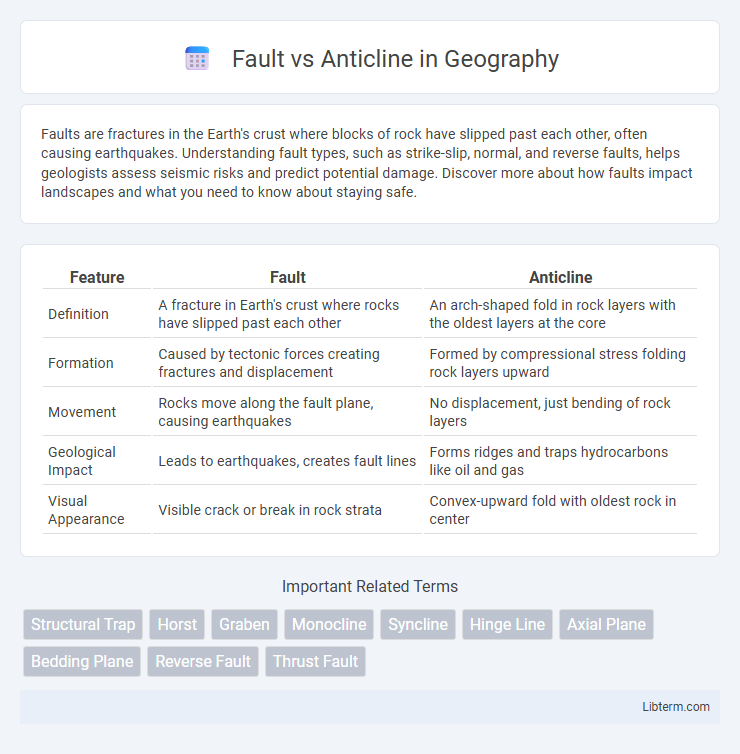Faults are fractures in the Earth's crust where blocks of rock have slipped past each other, often causing earthquakes. Understanding fault types, such as strike-slip, normal, and reverse faults, helps geologists assess seismic risks and predict potential damage. Discover more about how faults impact landscapes and what you need to know about staying safe.
Table of Comparison
| Feature | Fault | Anticline |
|---|---|---|
| Definition | A fracture in Earth's crust where rocks have slipped past each other | An arch-shaped fold in rock layers with the oldest layers at the core |
| Formation | Caused by tectonic forces creating fractures and displacement | Formed by compressional stress folding rock layers upward |
| Movement | Rocks move along the fault plane, causing earthquakes | No displacement, just bending of rock layers |
| Geological Impact | Leads to earthquakes, creates fault lines | Forms ridges and traps hydrocarbons like oil and gas |
| Visual Appearance | Visible crack or break in rock strata | Convex-upward fold with oldest rock in center |
Introduction to Faults and Anticlines
Faults are fractures in the Earth's crust where significant displacement has occurred due to tectonic forces, often associated with earthquakes and crustal deformation. Anticlines are upward-arching folds formed by compressional stresses that bend rock layers into convex shapes, commonly serving as traps for oil and natural gas accumulation. Both structures are critical in geological studies for understanding crustal movements and resource exploration.
Definition of Faults
Faults are fractures in the Earth's crust where significant displacement has occurred due to tectonic forces, resulting in the movement of rock masses along the fracture plane. Unlike anticlines, which are arch-like folds characterized by the upward convex curvature of rock layers, faults represent breakage and relative movement, often causing earthquakes. Faults are classified based on the direction of movement, including normal, reverse, and strike-slip faults, each influencing geological structures differently.
Types of Faults
Faults are fractures in Earth's crust where blocks of rock have slipped past each other, with types including normal faults, reverse faults, and strike-slip faults. Normal faults result from extensional forces pulling the crust apart, causing the hanging wall to move downward relative to the footwall. Reverse faults, often linked to compressional forces, have the hanging wall move upward, while strike-slip faults involve lateral horizontal movement along the fault plane.
Definition of Anticlines
Anticlines are geological formations characterized by upward-arching folds in rock strata, typically resulting from compressive forces in the Earth's crust. They serve as important structural traps for hydrocarbons, where the oldest rock layers form the core of the fold. Unlike faults, which involve fractures and displacement of rock layers, anticlines maintain continuous strata with bending but no breakage.
Types of Anticlines
Anticlines are categorized into several types, including symmetrical, asymmetrical, recumbent, and plunging anticlines, each defined by the orientation and angle of the fold axes. Symmetrical anticlines exhibit equal limb dips, while asymmetrical anticlines have one limb steeper than the other; recumbent anticlines show near-horizontal fold axes, and plunging anticlines have axes that tilt into the earth. Faults, in contrast, are fractures along which there has been significant displacement, and can interact with anticlines by modifying their structural geometry or forming fault-related folds.
Structural Differences: Faults vs Anticlines
Faults represent fractures in the Earth's crust where significant displacement has occurred, characterized by the movement of rock masses along a fracture plane. Anticlines are upward-arching folds in sedimentary layers formed by compressional forces, typically creating a convex shape with the oldest rocks at the core. The key structural difference lies in faults involving brittle failure and displacement, whereas anticlines result from ductile deformation and bending of rock strata.
Formation Processes
Faults form through brittle deformation when rocks experience stress exceeding their strength, causing fractures and displacement along the fault plane. Anticlines develop by ductile deformation, where compressional forces fold rock layers, creating an arch-like structure without fracturing. The key difference lies in fault formation by fracturing and movement, whereas anticlines form by bending and folding of strata under tectonic compression.
Geological Significance
Faults represent fractures in Earth's crust along which displacement occurs, fundamentally shaping regional tectonics and influencing rock deformation patterns. Anticlines are arch-shaped folds formed by compressional forces, serving as critical traps for hydrocarbons and indicators of past stress regimes. Their interplay controls subsurface fluid migration, seismic activity, and the structural evolution of sedimentary basins.
Identification and Mapping Techniques
Faults and anticlines can be identified and mapped using geophysical methods like seismic reflection and resistivity surveys that reveal subsurface structural discontinuities and folds. Geological field mapping involves measuring fault plane orientations and fold axis trends using tools such as a Brunton compass to record strike and dip, aiding in distinguishing fault planes from anticline hinges. Integration of remote sensing techniques with digital elevation models enhances the visualization of fault scarps and fold topography for accurate structural interpretation.
Economic and Environmental Implications
Faults can significantly impact mining operations by creating zones of weakness that facilitate resource extraction but also pose risks of ground instability and costly remediation. Anticlines often serve as structural traps for hydrocarbons, making them valuable targets for oil and gas exploration, but improper drilling may lead to environmental hazards such as groundwater contamination. Both geological features require careful assessment to balance economic benefits with environmental protection, ensuring sustainable resource development.
Fault Infographic

 libterm.com
libterm.com